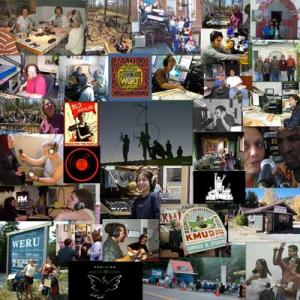Community radio is fundamentally not a technical enterprise, but a venture into building humanity. The KHOI FM project returns media to treasured and traditional person-to-person connections -especially as new technologies increase isolation. It reminds us that radio remains relevant even in the digital age.
Community radio is when local people produce and broadcast their own programs and participate in operating the station. It is community space for people to meet and collaborate. It is extraordinarily fun and often life-changing. It typically leads to individual creativity and self-empowerment. Participants find it extraordinarily satisfying, not just to make radio in this unique fashion, but to also help transform community life.
Community radio is a world-wide phenomenon. Its roots date back to the late 1940s when it was introduced as a way to offer media access to union members and their families during a labor strike in Bolivia. In 1949, Pacifica Foundation established the first community radio station in the United States. Since then, this vibrant media movement continues to spread throughout the world—from Western countries to remote third-world communities. The urge to do community radio fulfills the basic desire for communication and self-expression and is on the forefront of today’s democracy movements. Typically, two principal aims are achieved:
- Cultural, political and artistic voices excluded elsewhere get heard.
- Individuals and communities are enriched.
Community volunteers are trained and given a central role in radio production, operation and program development. Youths also get a chance to participate. Stations remain responsive to community needs and consistently seek input from listeners.
Benefits of Community Radio
Community radio is known for greatly improving a community's quality of life. This claim is substantiated by research conducted by Dr. Richard Florida of Carnegie Mellon University. In his book "Competing in the Age of Talent: Quality of Place and the New Economy” Florida explains how “quality of place” influences peoples' choice to move to a particular community. Based on data collected on labor pools, environment, recreational opportunities, cultural amenities, and the economies of 35 metropolitan areas, Florida made the following conclusions:
- Communities perceived as being inclusive, supportive of diversity, and possessed of a climate of “cultural variety” attracted skilled, innovative workers more effectively.
- Communities encouraging diversity and participatory civic culture—and possessed of highly developed cultural and environmental amenities—enjoyed long-term success in retaining talent.
- Sociological and environmental factors are increasingly as important as—if not more important than—economic factors in generating and sustaining regional health.
KHOI’s mission and goals encourage improved communication, inclusiveness, and access to diverse ideas. As described by Dr. Florida’s research, these goals translate into valuable community assets.
